Tom Phillips was een Engels kunstenaar vooral bekend omwille van A Humument (1970 – 2005), een vermeerderd (en verminderd) boek dat Phillips voor het eerst in 1970 uitbracht maar waar hij zijn hele leven aan zou blijven verder werken.
Hij ‘verbouwde’ of ‘behandelde’ een Victoriaanse roman van ene Mallock, getiteld A Human Document (1892) tot A Humument, ‘an Doc’ weglatend uit de titel. Hij schrapte woorden en zinnen maar voegde ook veel toe. Hij overschilderde pagina’s, telkens woorden uitsparend om zo tot een volledig nieuw boek te komen.
Het is een standaardwerk binnen de appropriatie en in dit geval wordt niemands eigendomsrecht geschonden want de originele roman is al lang in het publieke domein.
Een geweldig werk.
Rust in vrede Tom.


